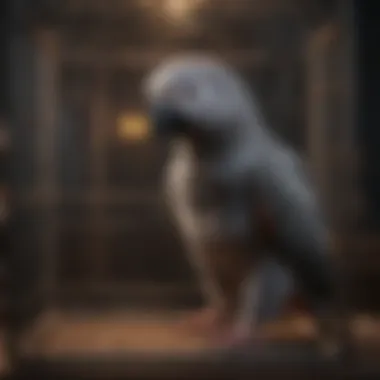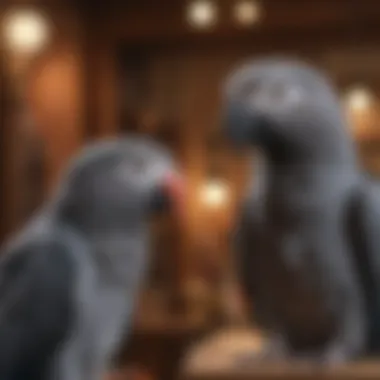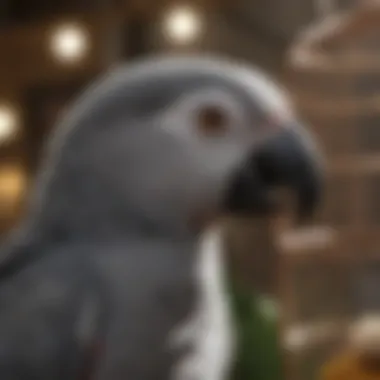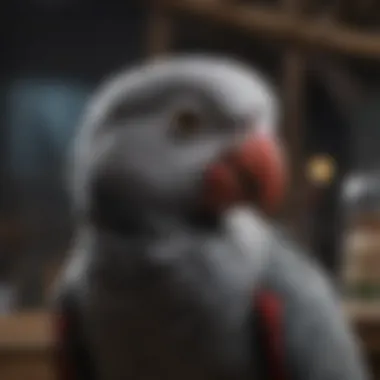Choosing the Best Cage for African Grey Parrots


Intro
Selecting the right bird cage for African Grey parrots requires careful consideration. These birds are known for their intelligence and strong personalities. Therefore, their habitat needs to accommodate their physical and mental needs. This guide addresses key factors such as size, design, and material, ensuring owners can make informed choices.
Understanding the specifics of African Greys will also enhance their well-being. A suitable cage will not only serve as a shelter but also promote play, exploration, and socialization. This article delves into various elements essential for creating an enriching environment for these remarkable birds.
Preface to African Grey Parrots
African Grey parrots are known for their exceptional intelligence and distinctive personalities. They require specific environments that cater to their needs. Choosing the right bird cage is a critical decision for any owner. The cage serves as the primary habitat for these birds, affecting their behavior, health, and overall well-being.
Natural Habitat and Behavior
In the wild, African Grey parrots inhabit the rainforests of Central and West Africa. They are highly social and typically live in flocks. This social structure is vital for their mental health. Wild African Greys engage in various activities such as foraging, climbing, and vocalizing. Understanding these behaviors helps owners replicate their natural habitat as much as possible. This includes providing a cage that allows for movement, play, and interaction.
African Greys also exhibit natural curiosity. They explore their environment thoroughly. A spacious cage with various perches and toys can minimize stress and encourage exercise. Owners must consider these behavioral traits when selecting a bird cage. The cage should mimic aspects of their wild habitat to provide mental stimulation.
Why Cage Choice Matters
The cage is not just a physical structure; it is an essential element in an African Grey's life. A poorly designed cage can lead to various issues, including frustration, lethargy, or even physical health problems. On the contrary, an optimal cage supports their intelligence and active lifestyle. It can help prevent behavioral problems that arise from boredom or confinement.
Choosing a cage that meets the specific needs of African Greys ultimately enhances their quality of life. Important factors include adequate size, appropriate materials, and accessible design. A well-chosen cage allows these birds to thrive, providing a safe space where they can express their natural behaviors.
"An African Grey's cage is more than a home; it's a vital component of their health and happiness."
Selecting the right cage contributes to a fulfilling life for these remarkable birds. It shows a commitment to their care, ensuring they have the necessary environment to flourish.
Key Factors in Cage Selection
Choosing the right cage for an African Grey parrot is critical for their well-being. These intelligent birds require adequate space and a safe environment to thrive. Selecting a suitable cage involves several factors that shape their living conditions. Understanding these elements not only improves the pet’s health but also facilitates easier management for the owner. Factors like cage size, materials, design, and accessibility significantly impact the quality of life for these birds.
Cage Size Requirements
Cage Dimensions and Volume
The dimensions of the cage play a crucial role in providing a comfortable habitat for an African Grey. Ideally, a cage should be spacious enough for the bird to move around freely. The minimum dimensions commonly recommended are 24 inches wide, 24 inches deep, and 36 inches tall, but larger is always better. This space allows for essential activities like flying, climbing, and exploring. A suitable volume enhances the bird’s physical and mental health. Too small a cage can lead to stress and behavioral issues.
Vertical vs Horizontal Space
African Greys often prefer to utilize vertical space, so a taller cage may be beneficial. These birds are natural climbers and enjoy perching at different heights. A vertical cage allows for a variety of perches and play areas at different levels. Conversely, horizontal space is valuable for flight and general movement. When selecting a cage, look for a balance that incorporates both vertical and horizontal dimensions to give the bird the best chance at engaging in natural behaviors.
Material Considerations
Metal vs Plastic
Cage material is another critical factor. Metal cages are generally favored for their durability. Stainless steel or powder-coated metals are excellent choices that resist corrosion and are easier to clean. On the other hand, plastic cages may seem appealing due to their lightweight nature but they can wear out quickly. A metal cage is a sound investment that can last for years, offering a sturdy and secure environment for the bird.


Toxicity and Safety
Ensuring safety through non-toxic materials is vital. Many cages are treated with finishes or contain substances that can be harmful. It is crucial to confirm that the cage components, including any coatings or paints, are bird-safe. A safe cage supports the overall health of the African Grey, reducing the chances of illness from exposure to harmful substances.
Bar Spacing and Design
Appropriate Bar Width
Bar spacing is another practical consideration. For African Greys, bars must be close enough together to prevent escapes but not so tight that they restrict movement. A spacing of 5/8 to 1 inch is typically appropriate. This prevents the bird from squeezing through and provides security while still allowing the bird to interact with the environment. The width must be carefully chosen to reduce the risk of injury.
Preventing Escape
The design of the cage should focus on preventing escape as well. Clever birds can manipulate cages, so it is important to choose designs that reduce this likelihood. Lock mechanisms should be secure yet easy for the owner to operate. Assessing the cage for potential weak spots can save you from future headaches. Invest in a cage design that prioritizes security while remaining user-friendly.
Accessibility and Convenience
Door Placement
Door placement affects accessibility for both the bird and the owner. A cage with multiple doors may be advantageous, allowing easier access for cleaning and interacting with the bird. Look for doors that swing open without disrupting the interior setup. Proper placement minimizes stress during daily activities and fosters positive interactions between the bird and owner.
Feeding Access
Feeding access should be clear and simple. Cages with easy-to-access feeding stations can enhance the overall experience for both bird and owner. Consider cages that include feed doors for hassle-free refills. An easy feeding setup encourages regular feeding routines and ensures that the bird’s dietary needs are met promptly. Bathtubs and water dishes should also be accessible without requiring excessive effort from the owner.
Cage Features for Enrichment
Cage features that focus on enrichment are crucial for the well-being of African Grey parrots. These intelligent birds require mental stimulation and physical activity to maintain their health. A well-designed cage can provide a stimulating environment that mimics aspects of their natural habitat, promoting a healthier lifestyle. When choosing these features, understanding the needs of African Greys is essential. A cage that allows for exploration, play, and comfort can significantly enhance their quality of life.
Play Areas and Perches
Types of Perches
Selecting the right types of perches is fundamental for the comfort and health of African Grey parrots. These birds spend much of their time on perches, making it vital to provide a variety of options. Natural wood perches, for instance, are a common choice as they provide texture that is similar to what they would find in nature.
Wooden perches can contribute to foot health by encouraging exercise and preventing foot problems. The rough texture helps to grind down their nails, reducing the need for nail trimming. However, it is important to ensure that any wood used is safe and untreated to avoid toxicity.
Metal perches are also available but may not provide the same level of comfort as wood. They can get very cold or hot, depending on the environment, which might deter some birds. Therefore, a combination of natural wood and select metal perches could be beneficial, offering both variation and comfort.
Playgyms and Toys
Playgyms and toys are vital for engaging African Grey parrots. They serve as important tools for physical and cognitive stimulation. A good playgym allows parrots to explore different heights and surfaces, which can mimic aspects of their natural behavior in the wild. These structures often come equipped with additional toys, encouraging play and engagement.
One key characteristic of playgyms is their design versatility. They can be made from various materials, including wood, plastic, or acrylic, ensuring safety and durability. Investing in quality playgyms can foster a happier parrot, as they provide mental challenges and opportunities for exercise.
However, it is important to rotate toys regularly to maintain their interest. Too many of the same toys can lead to boredom, which is not ideal for these intelligent birds.


Food and Water Stations
Feeder Types
Feeder types play a significant role in ensuring that African Grey parrots have a balanced diet. Various feeder designs exist, from simple bowls to more elaborate systems that encourage foraging behavior. A foraging feeder, for example, can stimulate a bird's natural instincts to search for food, providing both mental and physical exercise.
A key characteristic of effective feeders is that they are easy to clean. Hygiene is critical in preventing disease. Additionally, feeders that can be securely attached to the cage can reduce spillage and mess.
Some feeders also have mechanisms that allow birds to interact with their food, making feeding time an engaging experience instead of a mundane task. However, careful monitoring is required to ensure that feeders do not lead to overeating or encourage improper feeding habits.
Water Accessibility
Water accessibility is another essential aspect to consider. A clean and fresh water source must be readily available at all times. Automatic water dispensers or gravity-fed systems can be advantageous, as they ensure that birds have continuous access to water without frequent intervention.
Moreover, ensuring that these water sources are easy to refill and clean helps maintain hygiene and prevents contamination. Birds are sensitive to changes in their water, so regular checks are necessary.
Hiding Spaces
Importance of Shelter
Hiding spaces provide security for African Grey parrots, which can often feel vulnerable in their environment. These areas allow them to retreat and relax, mimicking natural behaviors observed in the wild. A good shelter option can reduce stress and make them feel more secure, ultimately improving their overall well-being.
Creating sheltered areas within the cage can help encourage exploration and reduce anxiety. This can be achieved through the use of hiding boxes or natural foliage. Keeping these areas well-structured will cater to each bird’s characteristics, as some may prefer enclosed spaces more than others.
Choosing Appropriate Materials
Choosing appropriate materials for hiding spaces is crucial. They should be safe, comfortable, and easy to maintain. Natural materials like untreated wood or specific types of fabrics can be suitable as they do not emit harmful chemicals.
Additionally, ensuring that the surfaces can be cleaned easily is vital to maintain a hygienic environment. Hiding spaces that are complex yet accessible can offer stimulation while providing a sense of comfort. Ultimately, the goal is to create an inviting atmosphere that allows African Grey parrots to thrive.
Popular Cage Models for African Greys
Choosing the right cage for African Grey parrots means considering various models that cater to their specific needs. Popular cage models can greatly impact the comfort and well-being of these intelligent birds. Each model offers unique benefits, making it easier for owners to find a suitable option that aligns with their preferences and budget.
High Evaluation Cages
High evaluation cages are often recommended by experts for their robust design and functionality. These cages can withstand the strong beaks and energetic nature of African Greys, making them ideal choices for serious bird owners.
Anderson Cage
The Anderson Cage is notable for its spacious layout and high-quality construction. One of its key characteristics is the ample space it provides for your bird to move around. This cage stands out due to its modular design, allowing owners to customize the interior with various perches and toys. The main advantage of the Anderson Cage is its durability, making it a long-term investment for pet bird owners. However, potential downsides include a higher price point, which may not suit everyone’s budget.
Avian Adventures Model
The Avian Adventures Model is another excellent choice for African Grey parrots. It is highly regarded for its vertical design, which maximizes space without taking too much floor area. A distinct feature of this model is its multiple access doors, allowing easy access for cleaning and interaction. Due to its strong metal frame and chew-resistant bars, this cage ensures safety for your bird. One disadvantage could be its weight, making it challenging to move once set in place.


Cost-Effective Options
For many bird owners, finding a cage that meets their needs while being budget-friendly is essential. Cost-effective options can provide a good balance between quality and affordability, ensuring that every pet can enjoy a suitable living space.
Zuper Kennel
The Zuper Kennel is a budget-friendly choice, favored for its practical design. It offers adequate space and features, making it a solid option for first-time bird owners. One of its key advantages is that it provides good ventilation and visibility, ensuring the well-being of your African Grey. However, a downside might be the lower durability compared to high-end models, meaning it may need replacement sooner than other cages.
Cages Under Budget
Cages under budget extend options for conscientious spenders while still considering the needs of African Grey parrots. These cages often come equipped with basic features like perches and food trays. One key characteristic is the variety available in size and design, catering to diverse preferences. Although they are less elaborate, they can still provide a suitable environment. Owners should keep in mind that while these cages serve their purpose, they may lack some of the robust features desired for long-term use.
Maintenance and Hygiene Considerations
Maintaining a clean and hygienic environment for African Grey parrots is critical for their health and well-being. These birds are susceptible to various diseases, many of which can originate from unsanitary living conditions. Improper maintenance not only impacts the birds' physical health but can also affect their mental state and overall quality of life. Therefore, a clear cleaning routine and awareness of wear and tear in their habitat are essential components of responsible bird ownership.
Regular Cleaning Routines
Establishing and adhering to a regular cleaning routine can greatly enhance the living conditions of African Greys. Here are some key elements to consider:
- Daily Tasks: Every day, it's important to remove any uneaten food, old water, and droppings. This minimizes bacteria buildup and unpleasant odors.
- Weekly Cleaning: A deep clean should occur weekly. This may include washing the cage bars, perches, and toys with mild soap and warm water, followed by thorough rinsing to eliminate any soap residue. Using non-toxic disinfectants can provide added security against pathogens.
- Surface Care: The bottom of the cage should be lined with easily replaceable papers or washable materials. This simplifies the cleaning process and helps maintain hygiene.
- Regular Inspection: As you clean, inspect the cage for any signs of damage or wear. This practice will help catch problems early, preventing larger issues that may arise from a neglected habitat.
The idea is to ensure the bird's living environment is as pristine as possible. A clean cage reflects a commitment to the bird's welfare and fosters a healthier habitat.
Regular cleaning is not merely a chore; it is an investment in your pet's health and happiness.
Assessing Wear and Tear
The integrity of the cage itself must also be assessed regularly. Over time, cages can show signs of wear and tear, which can compromise safety. Here are aspects to evaluate:
- Visual Inspection: Examine the cage for rust, corrosion, or sharp edges. Any damage can lead to injuries, so it’s vital to take action as soon as issues arise.
- Bar Stability: Ensure that all bars are secure. If any bars are loose or have been bent, they may not provide adequate security. Consider reinforcing or replacing them promptly.
- Loss of Coating: Many cages come with protective coatings. If these begin to peel or wear away, it can lead to rust. Ensure coatings are intact, and if peeling occurs, address it by replacing the cage.
- Functional Features: Check all doors, locks, and feeding stations. These parts should function smoothly to prevent escape or accidental openings.
Taking proactive measures in both maintenance routines and wear assessments not only enhances the lifespan of the cage but ensures a safe and comfortable environment for African Grey parrots. Such diligence ultimately leads to a more fulfilling experience for both the bird and its owner.
Ending
Choosing the right cage for your African Grey parrot is vital. Their well-being depends on it. A poorly designed cage can lead to stress and health issues. This article has highlighted significant factors like cage size, design, and material considerations. These elements are not just about aesthetics; they directly affect the bird's mental and physical health.
For instance, a spacious cage allows the parrot to move freely. This movement is crucial for their physical fitness. A cage with suitable bar spacing prevents escapes and ensures safety. Furthermore, the material choice affects both durability and toxicity. These details may seem minor, yet they contribute significantly to the overall environment of the bird.
In summary, understanding these factors enables bird owners to make educated choices. A well-chosen cage provides a safe haven, enriching the quality of life for African Greys. This understanding solidifies the bond between the bird and its owner.
Recapping Key Points
- Cage Size: Sufficient space is essential for African Grey parrots. It supports their physical health and allows for normal behaviors.
- Material Quality: Selecting non-toxic materials ensures the safety of the parrot, addressing any concerns regarding harmful chemicals.
- Bar Spacing: Proper spacing not only enhances safety but also prevents potential injuries.
- Accessibility: An accessible cage allows for easier cleaning and food/water access, making care more manageable.
Making an Informed Decision
When selecting a cage, it is crucial to assess individual needs and behaviors of your African Grey. Each bird is unique, and its environmental needs can vary. Consider factors such as:
- The parrot's size and age.
- Its activity level and typical behaviors.
- Personal lifestyle and the space available in your home.
Doing proper research is beneficial. It will help you find a cage that meets specific requirements while fostering a healthy environment. In the end, a well-thought-out decision reflects a commitment to enhancing your parrot’s quality of life. This thorough approach rewards both the owner and the bird with a harmonious and fulfilling companionship.















